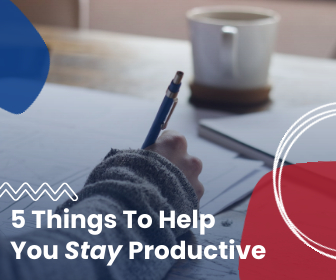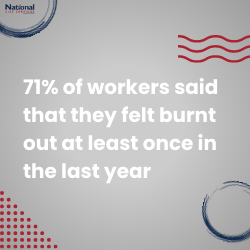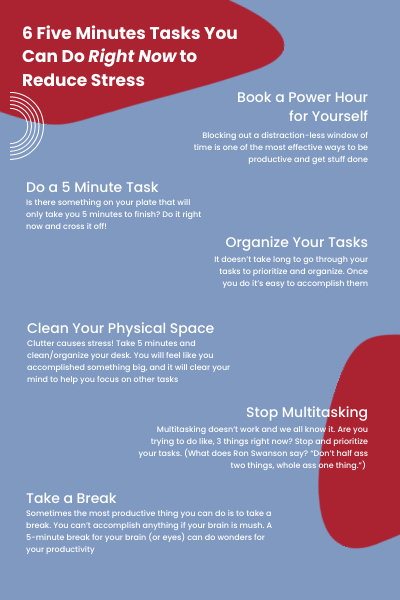Need a Refocus Break?

In this digital world, a lot of us probably spend more time at our desks than we’d like to. Long amounts of time staring at a computer can take a toll! Here’s a few things you can do to give you a physical and mental break.
Take a Stretch Break
Admit it, you’re sitting hunched over your keyboard or phone right now. 😜 Its ok; we all do it. Here’s 3 quick stretches you can do at your desk!

#1 Give Your Wrists Some Love
Being on the computer all day overuses some muscles and underuses others. New York City based physical therapist, Dr. Abby Bales, suggests stretching your wrist flexors and extenders. The easiest way to do this is to hold your arm straight out and bend your wrist up and down at 90 degree angles. Bales says this “prevents the wrist from getting locked in a smaller range.”

#2 De-Hunch
Your upper back and shoulders can lock from being at a desk too long. Dr. Bales suggests stretching by clasping your hands behind your head and squeezing your shoulder blades. This opens up your chest and shoulders, helping stop the hunch.
#3 Big Shrugs

While on the computer most of us have the habit of scrunching up our shoulders and leaning toward the screen. Doing some 3-5 second shoulders shrugs helps! “By actively shrugging and then letting go, the brain is made aware of the unhealthy height of the shoulders,” Dr. Bales said, and it resets accordingly.
Mental Resets
Anytime you disrupt your routine (either by doing little things like pausing to stretch or like, I don’t know, a global pandemic) you have opportunity to reset. What can you do to reset your brain?
#1 Breathe
Pausing and taking a couple deep breathes can help clear your mind, relax, and refocus. It’s as simple as just looking up from your computer or phone and focusing on your breathing for a bit.
#2 Reprioritize
Another thing you can do to mental reset is take a moment to go over your tasks and reprioritize. Ask yourself, “What is my overall goal for the day and what do I need to do next to reach that goal?” It’s critical to understand what tasks are most important. Inevitably things change throughout the day; deadlines move and priorities shift. Reorganizing your task list can help you to stay focused on what really matters and make it easier to adapt to shifting priorities.
#3 Change Up Your Surroundings
Changing something about your surroundings can help you refocus. Can you get up and move? Now that it’s summer, could you work outside? Disrupting your groove gives you the opportunity to reset your focus. Changing where you physically are or even something small like switching up your music is super effective!
What ways have you found to reset your focus and give yourself a physical or mental break?
5 Things To Help You Stay Productive

We often focus on tips and tricks to help your business, but nothing is important to your business than you! Did you know that April is Stress Awareness month and May is Mental Health Month? What can you do to make sure you are running at your highest capacity and stay productive?
Managing stress has been a challenge for a lot of people this year. In Asana’s Anatomy of Work 2021 study, 71% of workers said that they felt burnt out at least once in the last year. Also, 42% rated their stress levels as high or very high. When employees are stressed or exhausted, engagement and productivity dip and the whole company can feel the effects.
What Can You Do as A Team to Stay Productive?
Unfortunately, work related stress often has to do with environment. When one person id feeling burnt out on your team, it can bring the whole team down. What can you do to create a less stress inducing work environment?
Talk It Out
Ewww, right? However, it’s impossible to know what is wrong or how you can help a situation if you don’t know at the problem is. Take in interest in people you work with. Is there anything going on in their life that might be adding stress? Is a process or workflow just not working for and its making things difficult?
Once you understand how your team is feeling, don’t disregard it! See what you can do to make things run smoother.

Take Control Over Your Situation
We are all responsible for ourselves. If you are lucky enough to have anatomy in your job, use it! Think about what areas of your job are stressing you and then figure out what you can do to help the situation. For example, do you struggle with being productive in the afternoons because you hit a massive exhaustion wall? Could you be hitting that dip because you constantly don’t get enough sleep? Or does coffee make you crash? Those are things that you have control over and can change.
And after this year, more and more companies are realizing that giving their employees flexibility over schedule and in some cases, whether they want to work from home, actually increases productivity!
Minimize Distractions
The Asana study mentioned early found that “work about work” took up 60% of most employee’s days. That “work about work” is things like, meetings about processes, communicating about specific tasks, switching between tools, waiting for apps to load, searching for information, following up with team members about a project’s status, and managing shifted task priorities. A lot of those things are things that you don’t have control over. However, dealing with tasks like that can quickly give you the feeling of being on a work sized hamster wheel. That’s partly because “work about work” doesn’t feel like you are accomplishing anything.
What can help you feel in control? Figure out the right processes and find the right tools. If you can work with your team to put an effective process in place for dealing with collaborative projects. Part of that involves finding the right tools. There are so many workflow and team management tools available now that it shouldn’t be difficult to find one that works for you and your budget. (We are big fans of Teams/Planner and good old fashioned white boards.)
Time Management
Time management single handedly has the biggest impact on work stressor and burn out. Good time management can drastically increase your productivity and give you more time to focus on other aspects of your life. A healthy work-life balance will help aspects of your life, including reducing stress!
Connect Your Targets to Big Goals
Time management is about getting the work done, it about getting the right things done at the time. A big part of understanding and prioritizing what’s most important is know what your goals. And if you work for a company, what its goals are. A recent study found that only 26% of employees understand how their work relates to the overall company goals. How can you know what daily targets to set if you don’t understand where you are trying to go?
Only 26% of employees understand how their work relates to the overall company goals
This goes back to talk it out. If you have questions, ask! And if you are in a management position, work with your employees so everyone understands what they are doing to help the company reach its goals!
Prioritize and Organize
Its critical to understand what tasks are most important. Inevitably things change throughout the day; deadlines move and priorities shift. If you understand what’s most important in the grand scheme, however, it can make adapting to those changes easier. In the Asana study, they found that 29% of employees cited confusion on task priorities as a contributing factor to their burnout.

There are many different methods to prioritizing and organizing your daily tasks. The “Eat The Frog” method (named after the famous Mark Twain quote) encourages you to take care of the big or complex tasks first thing in the morning. This way you are productive right out the gate and don’t have a big task hanging over your head all day. Once you’ve eaten the frog you can move to other things.
Another popular method is David Allen’s “Getting Things Done” method. The first step in this method is write everything you need to get done down. Once you have an overview it’s easy to see what tasks are important. Writing it all down and putting it one place frees up brain power and lets you focus on actually getting the stuff done.
Plan Ahead
Writing down your targets for the next day before you finish for the night or as you think of it, helps you feel on top of the day as soon as it starts. Spending a few minutes to plan out tomorrow’s tasks is way easier than spending the first part of your day scrambling to remember what was a priority to get done that day. This will also help your work life balance because you don’t have to keep thinking about all you have tomorrow.
Say “No” or Delegate
This is a struggle, we know. But one advantage of having clear, prioritized tasks, is that you can see when a task is not a priority or not one you have time for. It’s easier to explain why you are saying no if everyone knows what your current priorities are. Sharing your clearly defined priorities with your team gives everyone more clearly. This is something that we have found to be successful. In our morning meeting we often go through what everyone’s priority tasks for the day are. By doing this, we know what each of us needs to be focusing on and how much a priority it is to reach our company goals. It also makes it easier to see where we could help.

Knowing what your team’s priorities are, can also make it easier to delegate tasks. Just because something is a priority task for you doesn’t mean it’s not important! Help it get to the right person and that benefits everyone.
Audit Your Tasks
Is there anything on your plate right now that doesn’t align with your goals? Ask yourself, is this task not a priority for today anymore? Or is it not a priority at all? If the task is still important but keeps getting moved to the bottom of your priorities, ask yourself if you are the right person to be handling it?
Another aspect of auditing task is looking at how you view the task. Are you procrastinating the task because you don’t really want to do it? It’s easy to add time to situations if want to avoid the task. However, tasks don’t usually take care of themselves. (wouldn’t that be nice?) procrastinating the task will just make it worse. And often, when we finally do something, we’ve been procrastinating, we find it wasn’t that difficult in the first place!
What have you found successful in dealing with work stress? Any time management tricks you swear by?
How Your Flow State Can Help Productivity

When was the last time you felt fully engaged in a task and the hours just melted away? That’s called your flow state, something that psychology researcher Mihaly Csikszentmihalyi, from Claremont Graduate University in California, identified. Here’s how your flow state can help your productivity!
Flow is simply that state of mind in which we feel and perform our best and feel at ease. We don’t have to wait for a flow state to happen — we can take steps that can allow us to access it.
Here are the 2 steps needed to tap into your flow state.
- First, you must observe yourself. For the next two weeks, observe yourself, notice what you’re doing, and look for the clues of flow: losing your sense of time or self, feeling that you’re acting with ease, gaining new insights, and having a positive feedback loop.
- Then, when you are in a state of flow, broaden your awareness: Notice and remember the activities surrounding you. Recognize what you’re physically doing and think about what you’re doing mentally.
Tell us your tips and tricks for staying productive!
How to Increase Your Adaptability

If this year has taught us anything it’s that being to react well to inevitability of change is a must-have trait. In venture investor Natalie Fratto’s TED Talk on adaptability, she focused on how we can work on a becoming more adaptable in the workplace.
Here are her three suggestions:
- Be proactive. Fratto says,“Adaptability has to be proactive, not reactive. We have to seek it out, exercise it and flex it like a muscle.” How can you seek out adaptability? Start by looking for gaps in your organization that need filled. For example, is your team having a hard time communicating with the podcast team? Take the opportunity to learn about podcasts and help bridge the communication gap. Putting yourself in a position to help can make it easier to adapt to new roles later.
- Look at things from another point of view. Being agreeable can actually be the opposite of adaptability. Occasionally (and respectfully) playing the devil’s advocate can help you and your team see things from a different viewpoint. This can prevent you from getting to attached to your opinions or view. Not being stuck to ideas promotes flexibility and creativity.
- Remember the times you changed your mind. “It’s helpful to write down the times where you were wrong, changed your mind, or made mistakes,” says Fratto. Instead of viewing the times you’ve made mistakes as negatives, view them in a more positive light. Focus on what you learned and how you were able to grow.
What ways have you had to adapt this year?
Why Does WFH Have A Bad History?

Many companies (including our own) have been forced to adapt to WFH this year. Many of us enjoy working from home now and flexibility it offers. Why haven’t companies pushed WFH before?
Well, they have. And it hasn’t always gone well. For example, in 2009 40% of IBM’s 386,000 employees in 173 counties worked from home. In 2017, however, thousands of them were called back to the office. Why? Revenue was slumping, and as Kate Lister of Global Workplace Analytics says, “Working from home is a strategic move, not just a tactical one that saves money. A lot of it comes down to trust. Do you trust your people?”
Taking a global pandemic out of the equation, what are the advantages of WFH? Employees regain valuable time in not having to commute and are able to set their own work schedules. Working in your comfortable home environment can increase productivity. Employers can cut costs with smaller office spaces and amenities. They can also hire people from all over, not worrying about proximity to the office. Deeping the talent pool pushes diversity and in turn, innovation.
In late May 2020, Morning Consult surveyed US workers, 54% said they wanted to work remotely. But of those already working remotely, over 50% said they feel less connected to their company, which highlights a larger problem with WFH: management. Jody Thompson, who worked on Best Buy’s failed WFH program, said that part of the reason the program failed was that when the company was doing poorly, management began to fear that they were giving their employees way too much freedom. “It went back to a philosophy of ‘If I can see people, that means they must be working.” she said. And so, the employees when back the office.
A lot of companies have been surprised by the productivity increases
“People are shocked. No one found a drop-in productivity. Most found an increase.”

A lot of companies have been surprised by the productivity increases coming from WFH. John Sullivan, a professor of management at San Francisco State University said, “People are shocked. No one found a drop-in productivity. Most found an increase.”
Proving that the problem may not be the employees, but how they are managed. Now that everyone has to work remotely, it has helped many managers understand what it’s like to work from home and what their employees need to WFH effectively.
So, as Jody Thompson said, it all comes down to trusting your employees.
What do you think has caused WFH to fail in the past? DO you think that technology like Zoom will help working remotely succeed this time?
Carve Out Your Own Office Space

Is your temporary home office starting to feel a little more permeant? What can you do to build a home office that you actually want to work in?
Step one. Figure out what you actually need. Do you actually need a standard desk? How about filing cabinets and office supplies? Understanding what you need will help you figure the space you need and what your priorities should be.
Where should you put it? Is sharing the dining room table not really working anymore? It can be difficult to want to mess up your homes aesthetic with a desk smashed into room. Incorporating your workspace into your living space may help you be more motivated and looking forward to working. Without being a corporate setting, you have more of an opportunity to decorate your space the way you want. This truly your space. You can fill it however you want and put it where you want. You don’t have to star at a wall all day if you don’t want. Put your desk in place where you can command the room, and you’ll feel like you got a promotion.
Even if WFH is temporary for you, it shouldn’t have to feel like it. You deserve to like your space and feel productive in it.
Need To Make WFH More Comfortable?

Are starting to dream of your office chair, you know the one with the nice lumbar support? Working from home and in a makeshift office space can take a toll on your body. So, what can you do to not get sore?
Are you having to work off your laptop? Laptops can be an ergonomic nightmare. Make sure that your laptop, or monitor is at eyebrow level, so you don’t have to be looking down. (Added bonus, you’ll look great in zoom meetings!) If possible, use an external keyboard and mouse. Keep the keyboard flat to give your wrists a break.
What about the awesome office chair with the lumbar support? Is there a way to mimic it with a dining room chair? A rolled-up hand towel works great as makeshift lumbar support. The lumbar support will help you sit straighter and relive some pressure from your lower back and neck. Lowering your chair or getting a footrest will help you be balanced and grounded, giving your back more of a rest as well.
Don’t forget to get up and move. Google some stretches that target whatever is sore. You may be surprised by how much a rolled-up hand towel and few stretches can improve your WFH experience.
You Deserve A Break

When you work from home it’s easy to feel like you always need to be actually working. Working from home can blur the line between “work” time and “you” time.
Therefore, it’s especially important to take some time out of the workday for yourself. Carving out that time can actually help you work more productively. Take short breaks when you feel you need them, even if it’s just getting up and stretching your legs for a bit.
Schedule a time to have lunch, away from your computer. You could even go out and get lunch at your favorite neighborhood lunch spot. (Just make sure you communicate with your team that you are stepping out for a bit.)
Set goals for yourself. Then treat yourself to a walk, a cup of coffee, or a snack when you cross tasks off your list. If possible, give yourself a change in scenery. Go to your favorite coffee shop and make it a goal to finish a specific project while you are there. Mix it up!
If you are not used to it, working from home can feel like a wrench in your daily life. Use your rewards as a way to make it enjoyable! It’s okay to have fun with it. If life gives you lemons… make some lemonade.
